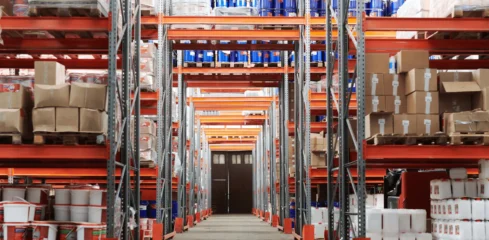How to Design a Warehouse Layout for Optimization

The importance of a practical warehouse layout design is significant for your operations. A good layout allows for better efficiency of movement and worker productivity. Plus, better layout designs ensure easier transitions to high-tech solutions such as using mobile barcode scanners for receiving or picking orders. All designs start with creating a plan to solve existing problems through improving current warehouse management and layout design.
Create a Warehouse Setup Plan
As your business grows, you will need to find more warehouse space one of two ways. First, you could rent a new warehouse. With high real estate costs in some areas, this may be prohibitive for many companies. For instance, small warehouses had rents rise by 30% and larger facility rents rose 15% from 2015 through 2020. To avoid incurring the costs of renting another facility, rearrange your existing warehouse layout to be more efficient.
Whichever choice you make, you will need to create a plan for designing your new or existing facility’s layout. To do so, pinpoint your priorities and problems that the new arrangement can improve.
1. Establish a Timeline
A setup plan starts with creating a timeline for planning, purchasing, setup and completion. Sticking to your timeline will reduce unexpected delays caused by the prolonged setting up of your new warehouse design.
2. Examine Priorities
What priorities does your facility have? Do you want to streamline receiving or speed up order picking? Do you need to change to an e-commerce warehouse layout? Does your facility lack storage space? The answers to these can help you to identify which areas you need to focus on when laying out your warehouse design.
3. Evaluate the Space
Evaluate the available space based on the equipment you currently have or will purchase. For instance, aisles must measure at least 12-feet wide to use standard counterbalanced forklifts with conventional storage racks. If you choose to use a narrow aisle storage arrangement or taller racking systems, you should upgrade to vehicles that can navigate the space, such as order pickers or reach trucks.
Also, plan out space for different areas of your warehouse. You need more than storage racks. Allow your plan to include receiving, packing, staging and returns stations. These areas require enough space for workers to have room to handle stock. Place packing and staging close together and pair receiving and returns with each other. These pairs of stations have similar tasks, and products pass between them. Having the stations adjacent to each other reduces walking time and effort, which makes your warehouse more efficient.
4. Assess Problems in the Current Warehouse Design to Solve
Examine how you currently use your facility by calculating the time required for receiving and picking orders. Count the number of touches each order goes through from receiving through shipping. Try to minimize this value by reducing the number of workers who handle it. Fewer people handling products reduces the chances of mistakes through human error, and you may want to reduce human error through automation.
During the planning stages, you should also take a look at your current stock. Do you have products that go missing? Or do you have products that you didn’t realize you had? Rearranging your warehouse for better product handling starts with taking an inventory of what you have.
5. Use Inventory Information to Plan Warehouse Arrangements
Inventory management systems today should include methods of quickly and accurately counting the stock you have and managing it through software. Barcode scanners can track stock received or picked. The information from these scanners goes into the warehouse management system (WMS) stock management software for your facility.
This software solution pairs warehouse management with stock handling and inventory control to give you the greatest amount of insight into what you have in your facility. This information on your current stock makes it easier to rearrange your warehouse for optimum efficiency. For example, with information from your inventory management system, you can identify fast and slow-moving products. Place best sellers toward the staging area to reduce walking and store slower selling goods farther away.
Also, consider the type of stock you carry. If you have perishables, you should use the last in, first out storage method. This storage option rotates stock to ensure products on the shelves the longest go out sooner. If you do not have perishable stock, you may be able to increase storage with front-loading push-back racks or double-deep racks. These storage options require a first-in, first-out (FIFO) order fulfillment method because you will not have easy access to the older products at the back of the racks.
Evaluate Your Budget and Existing Equipment
First, consider the budget you have for your warehouse upgrades. If you cannot afford to invest in an automated storage and retrieval system (AS/RS), don’t make that part of your design. Similarly, you should not go with the lowest-cost option if it does not contribute to your facility’s efficiency or long-term productivity. For instance, lower-cost storage racks may not have the weight capacity your stock requires. If you do not choose adequate racks or shelving, they could create a safety hazard or have reduced lifespans.
Existing equipment also includes your vehicles. If you only have standard forklifts and lack the budget for adding reach trucks or order pickers, you will need to retain standard aisle widths in your redesigned facility.
Consider the use of foot traffic and forklifts in your facility. If you have both using the same aisles, separate the space into pedestrian walkways and vehicular paths with floor markings. Other options include placing physical barriers between vehicular and pedestrian paths or using permanent railings. Separating traffic improves safety in your warehouse, allows for better movement of both pedestrians and lift vehicles and reduces the chances of vehicles striking those on foot.
Lastly, look at the available space you don’t use in your warehouse now. Is there empty space toward the ceiling you could use? Or do you have vehicles for use with narrow aisles but maintain standard separation between racks?
These situations both indicate wasted space you could put to use by increasing storage or working areas. Consider adding higher racks or integrating a mezzanine level for office space or additional storage. If you have the equipment to allow for closer racks, reducing aisle space can allow you to put more racks into your facility.
Create a Warehouse Design Blueprint
Your warehouse design blueprint needs to be a scale representation of your facility’s new arrangement, including the racking, aisle spacing, staging areas, storage locations, doors, loading docks, offices and receiving. When planning spaces, allow no more than 80%-85% of the facility to storage. Beyond this, there will not be enough space for workers to move around, and your warehouse will lack space for new arrivals.
Your warehouse blueprint should focus as much on maintaining smooth flows of movement of people and products as it does on maximizing storage. The need for receiving, stocking, pulling, packing and staging products explains why you cannot dedicate more than 85% of your facility to product storage.
Common arrangements of warehouses include U-shaped, I-shaped and L-shaped. These designs all depend on the location of docks at your facility:
- U-shaped: if you have docks on the same side of the building, you may consider a U-shaped design with each dock at one of the points of the U. One dock will serve for receiving goods. The receiving and returns areas should sit adjacent to this dock. Storage racks sit in the back, at the bend of the U-shape. The shipping dock, packing and shipping areas are at the other tip of the U.
- I-shaped: In an I-shaped warehouse, the receiving and shipping docks are at opposite ends of the building with storage in between. This simple design features a straight path from receiving through storage to packing and shipping.
- L-shaped: For L-shaped warehouses, the receiving shipping docks are at 90-degree angles to each other on different sides of the building. As with other designs, place the receiving and returns area near the incoming dock and the packing and shipping area at the outgoing dock. Storage racks sit between these areas.
For all designs, if your warehouse has a separate picking zone, place it next to the packing and shipping workplaces.
Plan for Technological Warehouse Optimization
Optimizing your warehouse for the modern era of increasingly demanded e-commerce means getting a better grasp of what you have in your inventory and how you handle it. If you will use barcode scanners for stocking and picking orders, you need to print out barcode labels for your stock. With customized barcode labels for use in your warehouse, you can avoid overlapping code information from existing UPCs on the stock.
For storing up to 4,000 characters of information, much more than a barcode can hold, consider printing out QR codes for your stock. QR codes can store product ID and lot ID information, while barcodes can only hold one of these pieces of information. Additionally, workers don’t need special barcode scanners to use QR codes. Instead, they can use smartphones or tablets to scan the codes. Scanners can read these codes from any direction or angle, reducing time wasted from improper scanning.
Assess Crucial Warehouse Design Principles
Look over your plans for your warehouse design to see how well they adhere to standard design principles for this space. These principles include the following:
Budget
How well does the plan fit your budget? Don’t overestimate your investment capacity. But you should plan to make long-term investments in equipment that will provide your warehouse a return on your investment in their longevity or improvements in efficiency.
Space
Space in your warehouse includes horizontal and vertical space. Consider how high your racks are and if you have the equipment to install taller storage units and reach stock located on them safely. You can also conserve space by opting for narrow-aisle vehicles, such as reach trucks or order pickers, and reduce the space between racks.
Flow
Look at the workflow through the warehouse. Workers should have a clear path from receiving to storage to packing and shipping. By keeping workflow moving in one direction, you can reduce wasted time and steps and avoid collisions from people going in opposite directions. You may even consider making aisles one-way to improve flow.
Accessibility
Everyone at your facility should be able to easily fulfill any order. Therefore, even rarely pulled products need to be accessible. Do not store products without having some way for workers to access them.
Equipment
The equipment you use will improve accessibility and flow. But your equipment will also place restrictions on your space and budget. For instance, if you choose a conveyor system to move products from storage to the packing and shipping area, allow for ample space for people and vehicles to move around the conveyor as needed. Make sure such additions fit into your budget and do not compromise your ability to purchase required goods, such as warehouse management software or storage racks to replace aging models.
Throughput
Throughput gives an indication of your warehouse’s efficiency. It refers to how many products pass through the entire series of steps from receiving to storage to picking to shipping. The more products you can process, the better productivity and operations are for your facility.
Personnel
Always include safety features in your warehouse to protect personnel. These may also fall under local building codes or standards.
Local Building Codes and Standards
Check with federal, state and area building codes for your warehouse and ensure your design aligns with those requirements.
Verify Compliance With Local Building Codes and Standards
Always use safety and fire codes as references when designing your warehouse. The specific codes you need to meet may depend on the type of stock you store. For instance, your facility may need to adhere to storage and handling rules for hazardous materials if you keep chemicals or similar substances on site.
In addition to codes, you should also consider the handling capacity of your equipment, which relates to worker safety. Make sure your equipment and space can handle live loads of stored products and material handling equipment. Use 250 pounds per square foot as a base for the live load levels in your space. Increase it as needed based on the stock your facility stores and purchase equipment to handle this amount.
Make Necessary Changes in Your Warehouse Layout for Workflow
Keep workflow optimization at the front of your mind during the blueprint creation of your warehouse. In fact, running a trial of the proposed arrangement could save you time and money after setup.
After creating your blueprint, test it by laying out outlines of the work zones, storage areas, aisles and racks with tape on the floor. Use your vehicles and foot traffic to test the viability of the proposed plan. If you notice any areas of bottlenecked traffic or inaccessible storage, amend your blueprint and test again. Doing this type of test will prevent you from noticing problems after moving storage equipment and other material handling gear.
Make all changes to your layout prior to finalizing your plan. By optimizing the movement of people and vehicles throughout your facility, you can improve efficiency and cut down on wasted time for order fulfillment or stocking.
Optimize Your Warehouse Inventory Systems and Design With Finale Inventory
Finale Inventory offers software solutions for managing inventory and orders. We have options that include mobile barcode scanning solutions for making changes to inventory when receiving orders or picking them. Plus, we offer warehouse management solutions that include stock management, e-commerce inventory monitoring systems and order management software integrations with shipping software.
Get started with optimizing your warehouse operations by improving the type of software you use for managing the system. Sign up for a free trial of Finale Inventory or contact us to schedule a demo.





